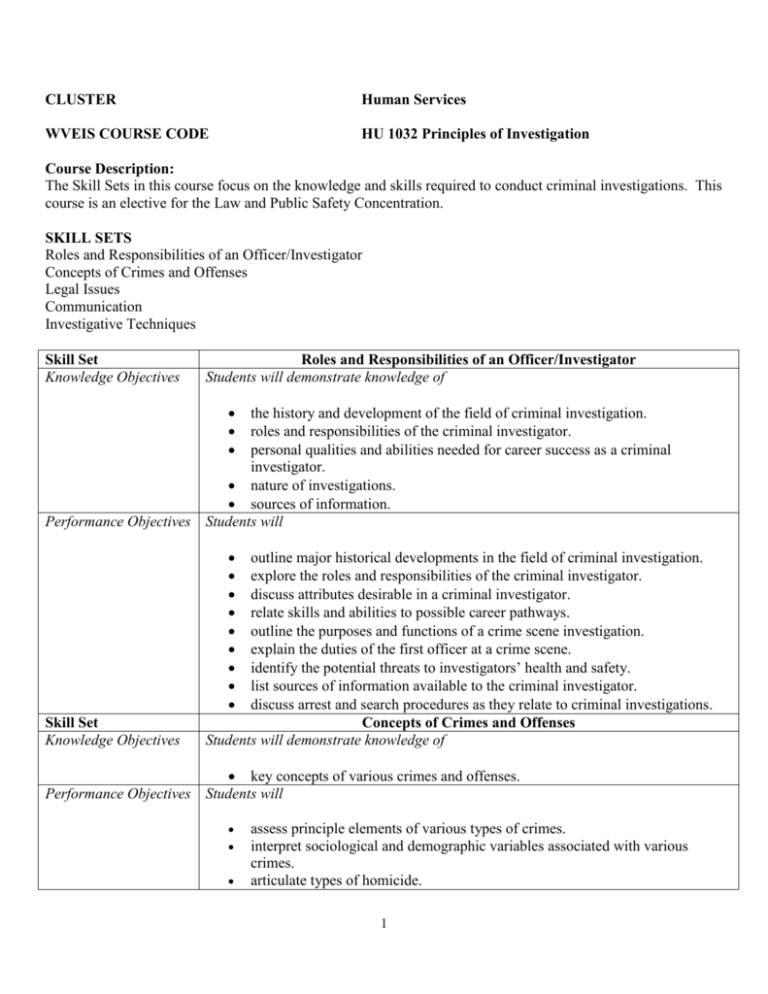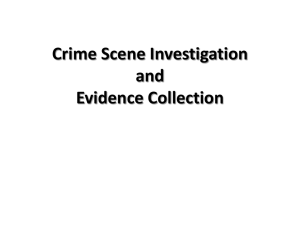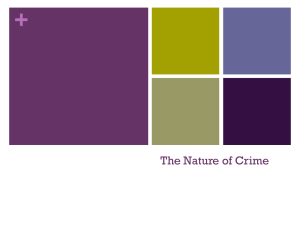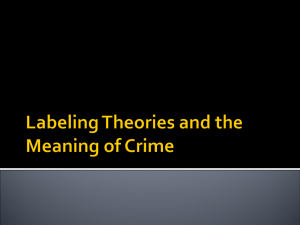1032 Principles of Investigation
advertisement

CLUSTER Human Services WVEIS COURSE CODE HU 1032 Principles of Investigation Course Description: The Skill Sets in this course focus on the knowledge and skills required to conduct criminal investigations. This course is an elective for the Law and Public Safety Concentration. SKILL SETS Roles and Responsibilities of an Officer/Investigator Concepts of Crimes and Offenses Legal Issues Communication Investigative Techniques Skill Set Knowledge Objectives Roles and Responsibilities of an Officer/Investigator Students will demonstrate knowledge of the history and development of the field of criminal investigation. roles and responsibilities of the criminal investigator. personal qualities and abilities needed for career success as a criminal investigator. nature of investigations. sources of information. Performance Objectives Students will Skill Set Knowledge Objectives outline major historical developments in the field of criminal investigation. explore the roles and responsibilities of the criminal investigator. discuss attributes desirable in a criminal investigator. relate skills and abilities to possible career pathways. outline the purposes and functions of a crime scene investigation. explain the duties of the first officer at a crime scene. identify the potential threats to investigators’ health and safety. list sources of information available to the criminal investigator. discuss arrest and search procedures as they relate to criminal investigations. Concepts of Crimes and Offenses Students will demonstrate knowledge of key concepts of various crimes and offenses. Performance Objectives Students will assess principle elements of various types of crimes. interpret sociological and demographic variables associated with various crimes. articulate types of homicide. 1 Skill Set Knowledge Objectives discuss information used to distinguish between homicide and suicide. discuss the concept of serial killing. identify types of drug-related offenses. explain the characteristics of poisoning. determine elements of various types of sex-related offenses. articulate the elements of the legal definition of rape. assess the importance of rape offender files. determine elements of the crime of arson. identify and explain the elements of robbery/burglary. discuss various terrorist groups and their actions. Legal Issues Students will demonstrate knowledge of legal issues as the relate to criminal justice topics. Performance Objectives Students will Skill Set Knowledge Objectives assess malum in se and malum prohibitum types of behavior. examine components of corpus delecti. explore the impact of Miranda v. Arizona and other Supreme Court cases on police interrogation. explain the concept of due process. apply the concept of case law. apply the concept of rules of evidence. determine legal issues involved in the collection, preservation and processing of physical evidence. articulate legal issues involved in crime scene processing. explain criteria for ensuring that evidence of guilt is admissible in court. Communication Students will demonstrate knowledge of concepts of effective communication skills. written communication skills. oral communication skills. interpreting information and ideas. feedback and supervision techniques. Performance Objectives Students will interpret verbal and nonverbal communication. apply basic speaking and active listening skills including reflection, restatement and clarification techniques. recognize barriers to communication. recognize the elements of communication using a sender-receiver model. apply speaking and active listening skills. recognize elements of written and electronic communication including writing a letter (spelling, grammar and formatting). 2 Skill Set Knowledge Objectives recognize the importance of courtesy and respect for customers and colleagues and maintain good interpersonal relationships. discuss how to adapt communication skills to varied levels of understanding and cultural orientation including diverse age, cultural, economic, ethnic and religious groups. investigate methods of supervision such as giving and receiving feedback and instruction. distinguish between and report subjective and objective information. report relevant information in order of occurrence. select and employ appropriate communication concepts and strategies to enhance oral and written communication in the workplace. locate, organize and reference written information from various sources. design, develop and deliver formal and informal presentations using appropriate media to engage and inform diverse audiences. develop and interpret tables and charts to support written and oral communication. Investigative Techniques Students will demonstrate knowledge of scientific principles and techniques of criminal investigation. types of evidence. types of intelligence. wound interpretation. crime scene reconstruction. methods for protecting and preserving evidence. methods for processing and documenting a crime scene. interrogation and interviewing techniques. kinesics. Performance Objectives Students will discuss the major events in the investigation of a crime. explain the major steps in a preliminary investigation. describe activities conducted in a follow-up investigation. define a crime scene. define crime scene reconstruction and state the types of reconstruction. explain the role of intelligence units and types of intelligence. distinguish between types of evidence including impressions, biological evidence, trace evidence and firearms/weapons). outline procedures for proper protocol. articulate procedures for processing a crime scene. describe the process for securing and protecting a crime scene. execute proper crime scene documentation (photograph/video/sketch). write effective notes (crime scene, interview, etc.) and accurate investigative reports. discuss the use of databases and photo line-ups. 3 discuss the use of physical surveillance. discuss the use of informants. explain the purpose of psychological profiling. describe a psychological autopsy. assess the importance of establishing the motive for certain crimes. describe action, physical and situational stereotyping. compare and contrast interrogation and interviewing. demonstrate proper interrogation and interviewing techniques. interpret various types of body language. explain the use of body language in criminal investigations. discuss how memory and perception may affect eyewitness reports. determine the characteristics of an effective witness. assess the key aspects of suspect identification. describe polygraphs, computer voice stress analysis, facial recognition software, the internet and other technology and discuss their applications. describe time-event charting, link analysis and telephone record analysis. identify financial difficulty indicators. chart the fundamental characteristics of gunshot wounds. explore the types of wounds associated with asphyxiation/strangulation. show the primary characteristics of cutting, stabbing and blunt force wounds. explain the role and importance of DNA analysis and describe current technologies for analysis and data banking. utilize proper collection, marking, preservation and processing methods for physical evidence. describe processes for transmitting physical evidence to the crime laboratory while maintaining chain of custody. describe processes for preserving footwear and tire prints and impressions. outline procedures for locating and handling soil and pollen evidence. summarize techniques for collecting glass and paint evidence. discuss methods of collecting and storing fibers, cloth fragments and impressions. discuss the identification and analysis of bloodstains and blood spatter. explain the importance of forensic dentistry and odontology. discuss the process of fingerprint identification and comparison. describe AFIS, IAFIS and NIBIN. discuss use of tools to obtain fingerprints. explain determinations that can be made from firearm evidence. apply the results of crime lab analysis on trace evidence to the investigation of a case. discuss the role of the forensic entomologist in determining time of death. explain autopsy protocol. describe methods for initiating cold case investigations. 4









